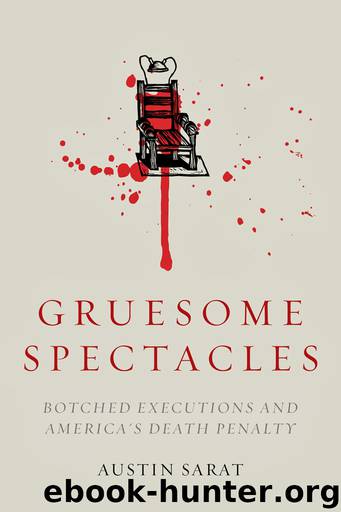Gruesome Spectacles by Sarat Austin

Author:Sarat, Austin [Sarat, Austin]
Language: eng
Format: epub, mobi
Publisher: Stanford University Press
Published: 2014-06-17T16:00:00+00:00
CHAPTER 3
When Science Fails
Electrocution
In August 1881 a thirty-year-old dockworker, George Lemeul Smith, known to his associates as a drunk, slipped past workers at the Brush Electric Light Company’s Ganson Street plant in Buffalo, New York. The Brush Plant, which housed the generators for Buffalo’s arc lights, was a local attraction as Buffalo was one of the first cities in the world to install these lights. The city’s residents, still wary and curious about the “magic” of electricity, often visited one of the facility’s largest generators, which sat just inside the door of the plant. As Smith entered the building that summer night, most likely inebriated, a worker heard him yell that he was going to “stop the generator.” He placed both of his hands on the machine, was electrocuted, and died immediately.1
Dr. Joseph Fowler, the county coroner, and Dr. Hoffmeyer, another physician, conducted an autopsy the next day. They were surprised to find that Smith had died so quickly, that his skin was neither charred nor burned, and that his body was not disfigured. Fowler found that Smith’s lungs were filled with blood. Initially he was unable to decisively identify the cause of death.
Unsatisfied with the first examination, Fowler conducted a second autopsy. He “[peeled back the skin from Smith’s arms and chest . . . [discovering] the path of the current: a line stretching from shoulder to shoulder, about two or three inches in width, where the flesh was a little darker than the tissue on either side. A force potent enough to fell a man in seconds left only a delicate tracing upon the flesh.”2 Even more surprising, Smith seemed to have died painlessly. G. W. Chaffee, the plant manager, and doctors Fowler and Hoffmeyer confirmed that fact to the local newspapers.3
Buffalo’s medical community and in particular a local dentist, Dr. Alfred Porter Southwick, were fascinated by the electrically induced death. Though Southwick never attended medical school, he helped form the State Dental Society and the Dental Department of the University of Buffalo.4 He focused on oral surgery and, in the course of his career, developed a groundbreaking procedure for treating cleft palates.5 Though local legend has it that Southwick witnessed Smith’s accidental death, in all likelihood he merely read about it in the local newspaper and, interested in learning more, attended a conference where Fowler presented his autopsy findings.6
Soon Southwick became obsessed with electricity. When he learned that Smith had died painlessly, he wondered about electricity’s potential to reduce pain in more traditional medical practices. That, however, was not the limit of his curiosity. Southwick teamed up with Dr. George Fell, another Buffalo doctor, and with the backing of the Buffalo Society for the Prevention to Animal Cruelty, began experimenting on a humane way of eliminating the city’s many stray animals by the use of an electric current.7
The results of the experiments were nonetheless brutal. Many of the animals were not killed outright or simply burned to death. After months of experimenting with various voltages, currents, and procedures, Southwick and Fell settled on a method that worked consistently.
Download
This site does not store any files on its server. We only index and link to content provided by other sites. Please contact the content providers to delete copyright contents if any and email us, we'll remove relevant links or contents immediately.
Waking Up by Sam Harris(1954)
Anatomy of Injustice by Raymond Bonner(1267)
Tangled Webs: How False Statements Are Undermining America: From Martha Stewart to Bernie Madoff by James B. Stewart(1025)
Coercing Virtue by Robert H. Bork(1022)
Broken Scales by Joel Cohen(1015)
Tangled Webs by James B. Stewart(921)
The Lawyer Bubble by Steven J. Harper(918)
Hiding from Humanity: Disgust, Shame, and the Law by Martha C. Nussbaum(880)
International Trade and Business: Law, Policy and Ethics by Gabriël Moens & Peter Gillies(867)
Five Last Acts by Chris Docker(852)
The Death of Common Sense by Philip K. Howard(808)
Freedom of the Will by Jonathan Edwards(804)
Zoopolis by Donaldson Sue; Kymlicka Will;(803)
Dignity, Rank, and Rights by Jeremy Waldron & Meir Dan-Cohen(798)
Oath Takers by L. Douglas Hogan(788)
Oath Takers by Hogan L. Douglas(720)
White Collar Criminals and the Financial Meltdown by Susan Will(708)
Fractured by unknow(696)
Gruesome Spectacles by Sarat Austin(682)
